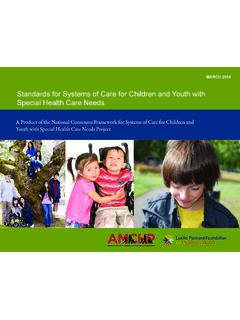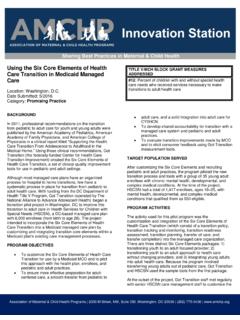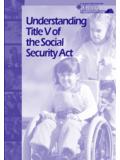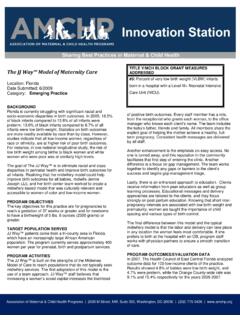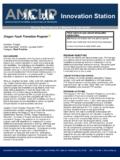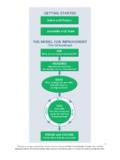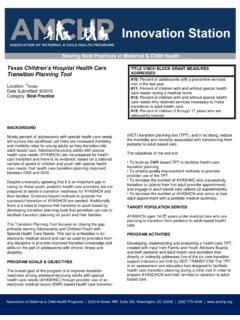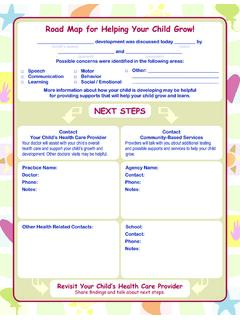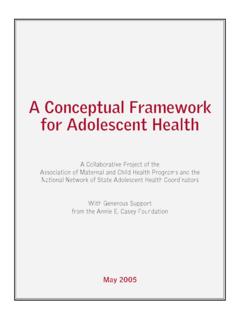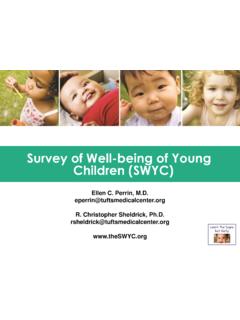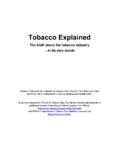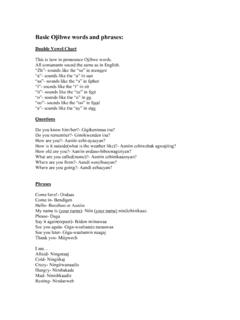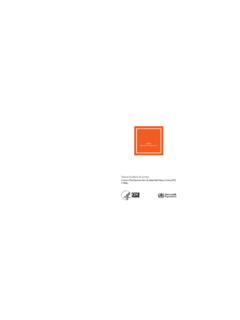Transcription of BABY & ME - Tobacco Free ProgramTM TITLE V/MCH BLOCK …
1 Association of Maternal & Child Health Programs | 1825 K Street, NW, Suite 250, Washington, DC 20006 | (202) 775-0436 | BABY & ME - Tobacco Free ProgramTM Location: 20 States Date Submitted: October 2017 Category: Best BACKGROUND Tobacco use remains the most common cause of pregnancy complications and death among infants. Babies born to women who smoke are more likely to be premature and underweight. They are also more likely to have certain birth defects such as cleft lip or palate. Smoking during pregnancy is also a risk factor for Sudden Unexpected Infant Death (SUID). Consequently, quitting smoking is the most important thing a pregnant woman can do for her health and the health of her baby. And yet research demonstrates that Tobacco exacts a terrible toll on health far beyond pregnancy, reaching across the entire life course. Children living in Tobacco smoke-filled homes are at greater risk for respiratory illness, middle ear infections, and reduced lung growth.
2 Plus, they are much more likely to become Tobacco users themselves. Therefore, for optimal lifelong health, it is critical to ensure that a mother and her family also maintain cessation after delivery. The BABY & ME Tobacco Free Program helps families quit smoking so they can live their lives free from the grip of Tobacco addiction, which is often a multi-generational issue. Created in 2001 in western New York, the core components of the program are based on recommendations from the Clinical Practice Guidelines, Treating Tobacco Use and Dependency (HRSA, 2008), tailored to the pregnant population. Early focus groups determined that the cost of diapers poses a constant worry for pregnant women and would therefore be an optimal incentive to assist in initiating and maintaining a successful quit attempt. PROGRAM OBJECTIVES The primary goal of this prevention program is to reduce infant mortality and morbidity. This is done in two ways: 1.
3 Improve birth outcomes by helping women quit smoking prenatally, and; 2. Reduce the exposure to second and thirdhand smoke in the home environment by maintaining cessation postnatally. TARGET POPULATION SERVED The BABY & ME Tobacco Free Program serves pregnant women who currently use Tobacco or who quit within three months of becoming pregnant. In most states, a qualifying support partner may also enroll. The participant is encouraged to enroll as early in her pregnancy as possible. There are no age or income requirements. PROGRAM ACTIVITIES The three elements of the program include: Face-to-Face Counseling Bio-Chemical Testing Contingency Management (Incentives) Each participant receives four, individualized prenatal sessions from a facilitator trained in Motivational Interviewing techniques. With the Transtheoretical Model as a framework, participants work through the Stages of Change. Tobacco cessation strategies tailored to each person s unique situation are developed together.
4 Participants are biochemically tested at each visit to verify status and, if nicotine-free, qualify to receive diaper vouchers each month up until their baby s first birthday. Ongoing support and education are interwoven throughout all encounters. TITLE V/MCH BLOCK GRANT MEASURES ADDRESSED #14. A) Percent of women who smoke during pregnancy and B) Percent of children who live in households where someone smokes BABY & ME - Tobacco Free Program (BMTFP) 2 | P a g e INNOVATION STATION | Sharing Best Practices in MCH PROGRAM OUTCOMES/EVALUATION DATA The BABY & ME Tobacco Free Program s design has proven effective in: Reducing the risk of delivering a low birthweight infant Reducing the number of cigarettes smoked per day by pregnant women Reducing hospital charges for the care of newborns Evaluation (Tennessee data published results): Reduced number of cigarettes smoked per day included cigarettes per day for participants who attended at least 3 prenatal sessions compared to cigarettes per day for non-participants Reduced rate of low birthweight birth with low birthweight for participants who attended at least three prenatal sessions compared to for non-participants Reduced hospital charges for care of newborns estimated at $ PROGRAM COST Program cost is determined by several factors: salary standards, training, data and technical support, outreach materials, biochemical testing equipment, and voucher costs, including dollar value and processing charges.
5 ASSETS & CHALLENGES Assets Increased focus on implementing programs with strong theoretical foundation and evidence-informed practice standards Diaper Voucher program and tracking mechanism in place with Wal-Mart Stores Challenges Funding: Sustaining an evidence-based program with frequent leadership change and funding stream instability and variation Capacity-Building: Successful program implementation in some high-need areas Overcoming Challenges Funding: Payor reimbursement for program is key to scale and sustainability efforts and is occurring in some states Capacity-Building: Increased technical assistance from national program office and train-the-trainer model available to offer more regionalized support LESSONS LEARNED Outreach efforts are necessary and translate into better outcomes System-wide data portal key to successful program evaluation and tracking across all sites Placement of program in agencies that serve women prenatally as well as in the postpartum period is optimal for participant retention FUTURE STEPS Scale and sustainability efforts continue to evolve so that more families nationwide can benefit from the program.
6 Some states are beginning to receive reimbursement by billing payors for counseling visits as well as diaper vouchers. COLLABORATIONS The national BABY & ME Tobacco Free Program office contracts with agencies to provide services at the community, county or state level. Implementing agencies include departments of public health, community-based health centers, physician offices, and other health and human service agencies. BMTFP continues to expand into new states and communities as the positive outcomes of this program become more widely known. PEER REVIEW & REPLICATION As of October 2017, BMTFP has served a total of 15,500 families. It has been implemented in 263 sites in 20 states across the United States. Gadomski, A., Adams, L., Tallman, N., Krupa, N., Jenkins, P. (2011). Effectiveness of a combined prenatal and postpartum smoking cessation program, Maternal and Child Health Journal, 15: 188-197. DOI Zhang, X., Devasia, R.
7 , Czarnecki,G., Frechette, J., Russell, S., & Behringer, B. (2017). Effects of incentive-based smoking cessation program for pregnant women on birth outcomes, Maternal and Child Health Journal, 21(4), 745-7. DOI RESOURCES PROVIDED Key words: smoking cessation, incentives, pregnancy, secondhand and thirdhand smoke, birth outcomes **For more information about this program please visit.
